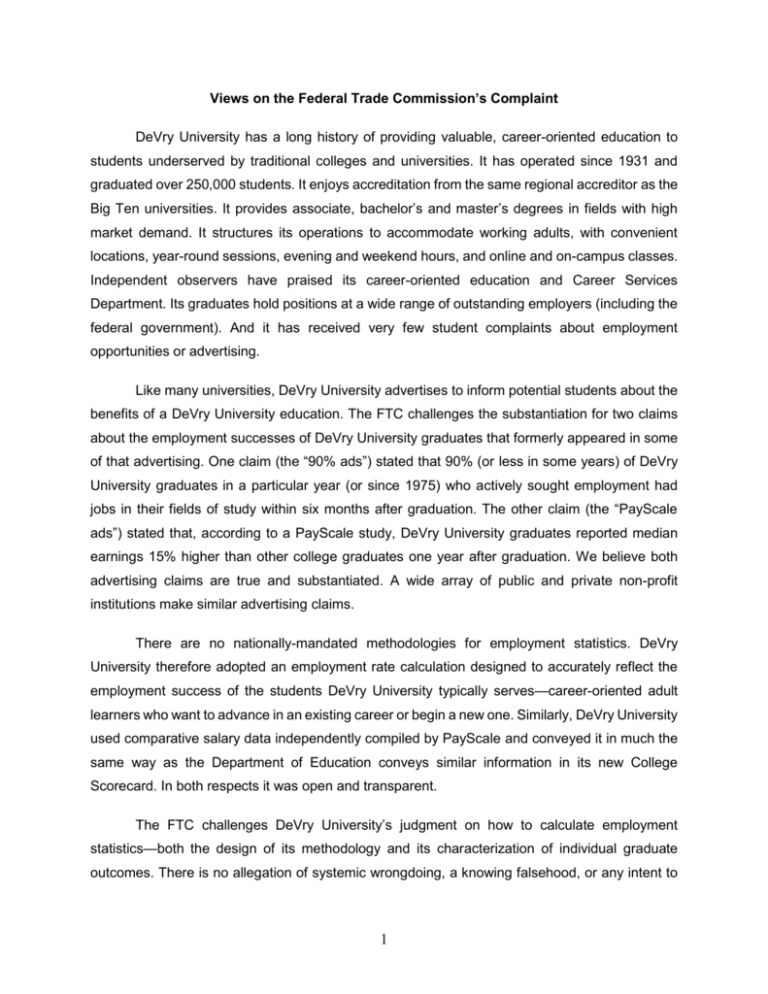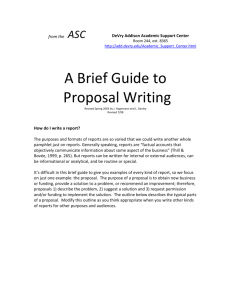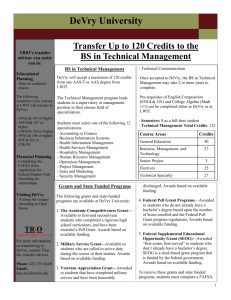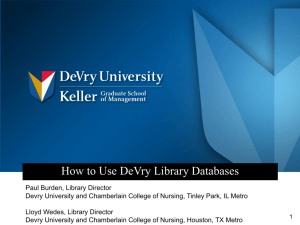Executive Summary - DeVry University
advertisement

Views on the Federal Trade Commission’s Complaint DeVry University has a long history of providing valuable, career-oriented education to students underserved by traditional colleges and universities. It has operated since 1931 and graduated over 250,000 students. It enjoys accreditation from the same regional accreditor as the Big Ten universities. It provides associate, bachelor’s and master’s degrees in fields with high market demand. It structures its operations to accommodate working adults, with convenient locations, year-round sessions, evening and weekend hours, and online and on-campus classes. Independent observers have praised its career-oriented education and Career Services Department. Its graduates hold positions at a wide range of outstanding employers (including the federal government). And it has received very few student complaints about employment opportunities or advertising. Like many universities, DeVry University advertises to inform potential students about the benefits of a DeVry University education. The FTC challenges the substantiation for two claims about the employment successes of DeVry University graduates that formerly appeared in some of that advertising. One claim (the “90% ads”) stated that 90% (or less in some years) of DeVry University graduates in a particular year (or since 1975) who actively sought employment had jobs in their fields of study within six months after graduation. The other claim (the “PayScale ads”) stated that, according to a PayScale study, DeVry University graduates reported median earnings 15% higher than other college graduates one year after graduation. We believe both advertising claims are true and substantiated. A wide array of public and private non-profit institutions make similar advertising claims. There are no nationally-mandated methodologies for employment statistics. DeVry University therefore adopted an employment rate calculation designed to accurately reflect the employment success of the students DeVry University typically serves—career-oriented adult learners who want to advance in an existing career or begin a new one. Similarly, DeVry University used comparative salary data independently compiled by PayScale and conveyed it in much the same way as the Department of Education conveys similar information in its new College Scorecard. In both respects it was open and transparent. The FTC challenges DeVry University’s judgment on how to calculate employment statistics—both the design of its methodology and its characterization of individual graduate outcomes. There is no allegation of systemic wrongdoing, a knowing falsehood, or any intent to 1 deceive. And there is no allegation, as in some of the cases the FTC has brought, of a worthless or sham service; it implicitly acknowledges the value of a DeVry University education. We believe the FTC’s objections about DeVry University’s judgment in calculating its statistics are inadequate to establish that its ads were deceptive, particularly when the calculation methodologies were fully disclosed. The Challenged Advertisements. We feel confident the two advertising messages challenged in the Complaint—the “90% ads” and the “PayScale ads”—comply with Section 5 of the FTC Act. For the reasons outlined below, we expect the evidence to show that the ads in question were neither deceptive nor unsubstantiated. Among other things, both were supplemented by additional, detailed information provided to every prospective student before enrollment, which included a detailed Employment Statistics Disclosure. The FTC Policy Statement Regarding Advertising Substantiation requires an advertiser to have “a reasonable basis” for its claims. And the FTC will “take care to assure that it only challenges reasonable interpretations of advertising claims.” We believe the net impression of the ads, as confirmed by the mosaic of information communicated in the admissions process, is not susceptible to misinterpretation, when viewed reasonably. A. The Challenged “90% Ads.” The first set of challenged advertisements stated that 90% (or less in some years) of DeVry University graduates who “actively sought” employment “had careers” or were “employed” “in their fields” of study within six months of graduating. These ads contained footnotes explaining how DeVry University calculated the employment rate. A typical footnote read: “Figure based on 2012 graduates self-reporting data to [DeVry University] Career Services who were employed at graduation or actively seeking employment in their field after graduation. Does not include master’s degree graduates or graduates who were not actively seeking employment, as determined by DeVry, or who did not report data on employment status to DeVry.” In addition, the detailed Employment Statistics Disclosure received by every prospective student further described the calculation of DeVry University’s employment statistics, provided underlying figures for specific degree programs, and prominently stated that “DeVry cannot guarantee employment.” 2 DeVry University created the “90% ads” using an employment rate methodology properly reflective of its student demographic (largely nontraditional, working students attending part-time) and DeVry University’s mission to provide career-oriented education. DeVry University also went to great lengths to ensure that the employment data used in that calculation was accurate. Through one-on-one communications between Career Services advisors and graduates, DeVry University carefully compiled and contemporaneously recorded graduate-by-graduate data for each graduation date going back to at least 1975. And DeVry University had strict policies and procedures to prevent any artificial boosting of employment rates and to verify data before publication. Despite everything DeVry University did to accurately communicate a meaningful graduate employment rate to prospective students, the Complaint asserts that the 90% ads were false, misleading or unsubstantiated. We believe the evidence shows that DeVry University’s math was correct, its methodology was reasonable, and its message was truthful. Continuing employment. The FTC alleges that the ads imply that 90% of DeVry University graduates can expect a new job, which is allegedly misleading because many graduates are counted in the 90% who continued in “old jobs” they had before they graduated. But the ads make no mention of a “new job.” They consistently stated in the main text that the employment statistics measured graduates who were “employed” or “had careers” either at graduation or within six months of graduation. The Employment Statistics Disclosure underscored this message by confirming that the employment statistics include graduates “who were already employed.” DeVry University reasonably included those with continuing employment in its employment rate because many DeVry University students are seeking to maintain or enhance their current employment with additional educational credentials. Graduates with continuing employment receive quantifiable benefits from their degrees. Including those with continuing employment accurately portrays DeVry University graduates’ employment successes to prospective students, many of whom want to retain their current jobs. Indeed, at least 12% of 2012 and 2013 graduates with continuing in-field employment benefitted from an employer sponsorship. Government regulators and experts in the field have expressly agreed with the practice of counting those with continuing employment in calculating a graduate employment rate. For 3 example, in a recent settlement, 40 Attorneys General prescribed a methodology that allowed continuing employment in the calculation of graduate placement rates. Similarly, the “FirstDestination Survey Standards and Protocols” promulgated by the well-respected National Association of Colleges and Employers requires employment-rate calculations to include continuing employment, even if an employed graduate is seeking a new position. These authorities recognize that a degree can be invaluable in maintaining current employment and open the door for future advancement. Indeed, the real risk of misinterpretation would have come from counting all graduates with continuing employment as not employed. That would have portrayed the employment success of those graduates inaccurately. DeVry University’s way of doing this was better, in our estimation. Furthermore, our research indicates that DeVry University’s choice of how to count these graduates was not a significant driver of its employment rate. Had DeVry University simply excluded all graduates with continuing employment, the percentage of 2013 graduates employed in field would have changed from 90.9% to 87.3%. Given that DeVry University advertised employment rates as low as 86% in recent years, its choice cannot be fairly characterized as rooted in self-interest. In-field employment. The Complaint includes a small number of anecdotes involving students allegedly misclassified as employed in their field of study by DeVry University. It goes on from there to allege that an unspecified but nonetheless significant number of graduates were misclassified. We see this as trying to make a mountain out of a molehill. DeVry University meticulously compiled statistics regarding in-field employment based on student self-reported data. For example, in 2013, graduates signed a form that asked whether they were “using knowledge, skills and abilities acquired through your degree for at least some of the regular job duties of this job.” Career Services personnel then checked each graduate’s selfassessment. DeVry University policies cautioned that amendments to a graduate’s determination of in-field employment “should be the rare exception” and made clear that Career Services personnel could be disciplined or terminated for reporting false data. DeVry University’s reclassifications were for the purpose of ensuring consistent, reliable data and, therefore, went in both directions, with some amendments lowering DeVry University’s statistic. The FTC does not disclose how many alleged mistakes there were or how such mistakes allegedly impacted DeVry University’s reported number. We believe the evidence will demonstrate that mistakes were isolated and went in both directions. 4 The small number of anecdotal examples the FTC has identified point to an absence of any bias or manipulation in the classifications. The law does not require perfection; advertising claims need only have a “reasonable basis.” DeVry University’s in-field classifications easily pass that test. Inactives. DeVry University excludes from its graduate employment calculation those graduates who are determined not to be actively seeking jobs in their field in the same way that the Department of Labor excludes from the national unemployment rate those who are not looking for a job. The FTC challenges DeVry University’s methodology because it excludes from its graduate employment calculation graduates who were not actively seeking employment in their field of study during the six months following graduation. It also challenges how DeVry University determined whether graduates were actively seeking employment in their field of study. And the Complaint asserts that DeVry University misclassified an unspecified but allegedly significant number of unemployed graduates who were actively seeking employment in their field of study as “inactive.” These contentions miss the mark. The U.S. Department of Labor excludes from its calculation of the national unemployment rate “those who have no job and are not looking for one.” DeVry University’s methodology adopted the same logic in removing from its calculation of graduate employment those unemployed graduates who were not actively seeking employment in their field of study. At least one national accreditor prescribes this practice for the 500 institutions it accredits. The text and footnotes of the challenged ads expressly stated that DeVry University’s employment statistics were based on graduates who were “actively seeking employment.” The Employment Statistics Disclosure sheet contained similar disclosures and, furthermore, detailed what DeVry University’s employment rate would have been if such graduates were included in the rate. DeVry University also followed a rigorous process before classifying any graduate as inactive under its policy. Only after 13 weeks and continuing inactivity—including failure to respond to three separate notification letters of increasing urgency from Career Services—would a graduate be classified as inactive. And DeVry University directed Career Services advisors to minimize the number of inactive graduates, with the goal of encouraging graduates to take advantage of this service. Furthermore, it was reasonable for DeVry University to classify as 5 inactive those graduates who did not respond to Career Services’ multiple outreach efforts and did not report their employment status to DeVry University. Working with Career Services for a meaningful period of time is a good proxy for an active job search because any graduate earnestly conducting a job search would not ignore this valuable resource for months on end. As every DeVry University student learns in a mandatory job-finding course, Career Services helps students identify job openings, works with them on their applications, resumes, and interviewing skills, sponsors job fairs, and has strong, long-term relationships with employers. Further, when graduates ignore Career Services’ outreach, DeVry University cannot know which non-responsive graduates are actively seeking employment, which are not, and which have found a job. They essentially represent a blind spot. Including these graduates in the calculation would have required DeVry University to designate them as either employed or not employed. Either way would have been fraught with problems and risk of error. DeVry University’s treatment of these graduates, excluding them from the calculation, was reasonable, balanced and disclosed for the avoidance of doubt. Net impression. Finally, it is alleged that the net impression of the challenged ads was that 90% of DeVry University graduates are assured a new and better job upon graduation. The Commission’s interpretation ignores the plain language of the ads, injects novel meanings into them, and overlooks accompanying disclosures included in the mosaic of information provided. The ads conveyed a historical result, phrased in the past tense, that 9 out of 10 DeVry University graduates who actively sought employment had careers in their field of study within six months. And the text and footnotes of the ads made clear how DeVry University calculated its graduate employment statistics. The ads appropriately addressed the two different groups of prospective students at DeVry University: (a) those who want to start a new career and (b) those who want to maintain or advance current careers. For both groups, the ads merely communicated that those who do the work to graduate have a strong chance to be working in their field of study reasonably soon after graduation if they are in the active job market. The accompanying Employment Statistics Disclosure sheet amplified these disclosures and expressly warned students that DeVry University could not guaranty employment. B. The Challenged “PayScale Ads.” The second set of challenged advertisements stated that, according to a third-party PayScale study, DeVry University graduates reported median earnings 15% higher than 6 graduates of other schools one year after graduation. DeVry University commissioned PayScale, an independent company that maintains an extensive database of salary and employment information, to compare the earnings of DeVry University graduates to those of other schools’ graduates. PayScale reported that the median salary of a DeVry University bachelor’s degree graduates, one year out of school, was 15% higher than similar graduates of other schools. The ads also disclosed that the 15% figure was based on a “PayScale.com study” of earnings reported by “73,309 bachelor’s degree graduates,” including “620 DeVry graduates.” The ads further cautioned that “[s]elf-reported information may not reflect actual earnings and may not be representative of earnings of individuals that do not supply information” and that “[r]esults may not be statistically significant.” The Complaint does not claim that PayScale’s results were false. Rather, it alleges that it was unreasonable for DeVry University to rely on them as proper substantiation for the ads because PayScale’s data was not adjusted for “salary drivers such as age, experience, and degree field” and DeVry University supposedly had access to earnings data contradicting the PayScale results. Those concerns are unfounded. Reasonable Reliance. PayScale’s data is reliable and widely-cited. PayScale has addressed the very same kind of questions underlying the FTC’s allegations. DeVry University raised questions with PayScale regarding these same issues and received comprehensive, thoughtful responses from PayScale’s statisticians. DeVry University also conducted reasonable diligence to understand PayScale’s methodology. Under the FTC’s own policies, it was reasonable for DeVry University to use these reliable results from this independent third party to substantiate its advertisements. In fact, the White House and the Department of Education have encouraged students to consider PayScale analyses, stating that PayScale “offers consumers a large salary database” and provides “return-on-investment” analysis for various colleges. And many prominent news sources (e.g., The Wall Street Journal, The New York Times), companies (e.g., Bloomberg), and universities (e.g., Princeton, University of Virginia) likewise rely on PayScale data. Salary Drivers. The assertion that DeVry University improperly relied on the PayScale salary data because that data failed to account for “salary drivers,” particularly age, is misguided. PayScale determined that college major was the primary factor for determining salary level and income growth for DeVry University graduates. That makes sense. DeVry University provides career-focused programs targeting high-demand fields such as technology, healthcare and 7 business. PayScale also informed DeVry University that it does not consider the age of graduates as a factor that should be singled out. The federal government publishes comparative earnings information that would be subject to many of the same criticisms the FTC has leveled against DeVry University’s PayScale ads, were these criticisms valid. For each school, the Department of Education’s College Scorecard reports the percentage of former students who, six years after first enrollment, earn more than the average earnings of a high school graduate. There is no indication that the reported figures account for age, experience, degree field, or any other salary drivers. Nor do the figures come with disclosures about their limitations as a predictor of any particular student’s earnings. The FTC essentially alleges that DeVry University’s reliance on PayScale was improper because its data does not control for the age of DeVry University’s graduates, which favored DeVry University in earnings comparisons because graduates of other colleges tend to be younger and less experienced in the workforce. But this contention is narrow and one-sided. The PayScale data does not control for other salary drivers besides age, like family wealth, SAT scores, quality of pre-collegiate education, and parent education, which all tend to favor institutions serving the most advantaged students in comparisons of graduate earnings. Conclusion DeVry University believes the FTC’s lawsuit is without merit. It is important to note that the FTC’s complaint challenges DeVry University’s judgment on how to calculate employment statistics – both the design of its methodology and its characterization of individual graduate outcomes. The FTC does not allege that DeVry University engaged in widespread or systemic scheme to defraud, had inadequate controls, sold a worthless product or violated any standards set forth by state or federal regulators or accreditors regarding calculating graduate outcomes. The FTC does not challenge DeVry University’s compliance with federal standards because there is no federal or national standard for calculating employment statistics. DeVry Education Group has called for a national standard for all of higher education without success. In the absence of regulation, DeVry University designed a very sound methodology for calculating the employment outcomes of its graduates. Our view was reinforced recently when a taskforce of 40 Attorneys General prescribed a methodology very similar to the one DeVry University has had in place for years, the one that is now being challenged. 8 In essence, the FTC alleges only that DeVry University should have calculated the employment statistics in the challenged ads in a different way – with no clear indication of what that different way might be or the statistical impact had it done so. The other challenged ads that highlighted DeVry University bachelor’s degree graduates’ median earnings compared to other schools are backed by a PayScale study. PayScale is a reputable, independent source for salary data and is cited by schools like Princeton, the University of Virginia and Northwestern University, as well as media outlets like the Wall Street Journal and the New York Times. The FTC’s primary concern with these ads is that PayScale did not control for significant salary drivers like age, experience and degree field. The recently- created White House College Scorecard does not control for those exact same salary drivers. If PayScale is misleading, then so is the College Scorecard. DeVry University has over a quarter million alumni, many of whom work at the most respected employers in the nation, including 95 of the Fortune 100 companies, as well as the federal government itself. This reflects DeVry University’s intense focus on career-oriented education – a hallmark of its founding in 1931 and a focus that continues to this very day. DeVry University’s employment statistics reflect that proud legacy and its commitment to student success. 9





